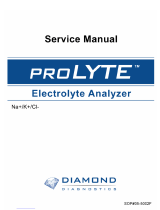
Roche Diagnostics
20 Instructions for Use · Version 8.0
1 Safety information 9180 Electrolyte Analyzer
Safety precautions
Reagents and working solutions
Skin inflammation or injury Direct contact with reagents, detergents, cleaning solutions, or other working
solutions may cause skin irritation, inflammation, or burns.
o When you handle reagents, exercise the precautions required for handling
laboratory reagents.
o Wear appropriate personal protective equipment.
o Observe the instructions given in the Instructions for Use.
o Observe the information given in Material Safety Data Sheets (available for Roche
Diagnostics reagents and cleaning solutions).
o If reagents, detergents, or other cleaning solutions come into contact with your
skin, wash the affected area immediately with soap and water and apply a
disinfectant. Consult a physician.
Fire and burns Alcohol is a flammable substance.
o Keep all sources of ignition (such as sparks, flames, or heat) away from the system
when you perform maintenance or checks that involve alcohol.
o When you use alcohol on or around the system, use no more than 20 mL at a
time.
Incorrect results
Poor accuracy and precision Incorrect results may lead to errors in diagnosis, posing danger to the patient.
o For the proper use of the system, run QC tests and monitor the system during
operation.
o Do not use reagents or consumables that have exceeded their expiry date,
otherwise you may obtain inaccurate data.
o For diagnostic purposes, always assess the results with the patient’s medical
history, clinical examination, and results from other consultations.
Incorrect reagent volume Incorrect reagent handling may cause an undetectable loss of reagent.
o Always store reagents according to the specified storage conditions as stated in
the Instructions for Use for the test.
Foam, clots, films, or bubbles Incorrect results may occur due to foam, fibrin clots, films, or bubbles in reagents or
samples.
o Avoid the formation of foam, clots, and bubbles in all reagents, samples,
calibrators, and controls.
Evaporation of samples or
reagents
Evaporation of samples or reagents may lead to incorrect or invalid results.
o Sample material may evaporate if left open. Do not leave samples open for any
length of time.
o Do not use improperly stored reagents. Ensure that reagents are stored according
to the Instructions for Use.
Carryover Traces of analytes or reagents may be carried over from one test to the next.
o Take adequate measures (for example, extra wash cycles) to avoid extra testing
and potentially incorrect results.
























